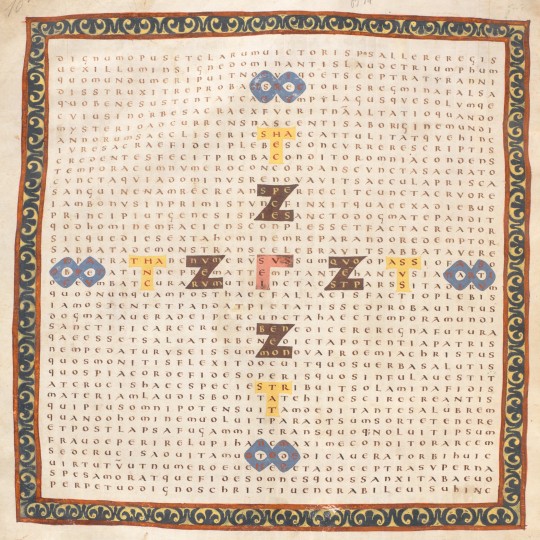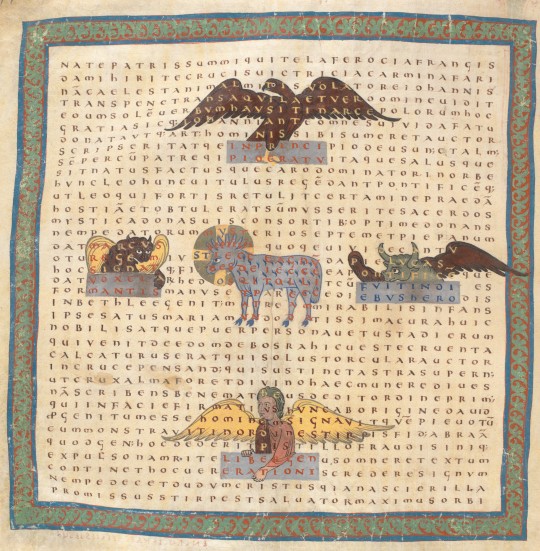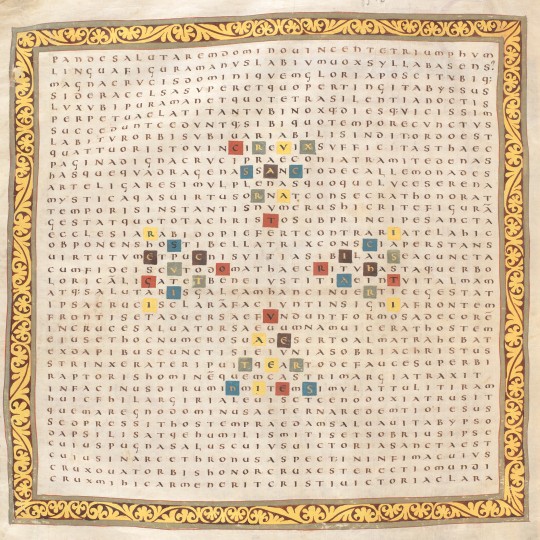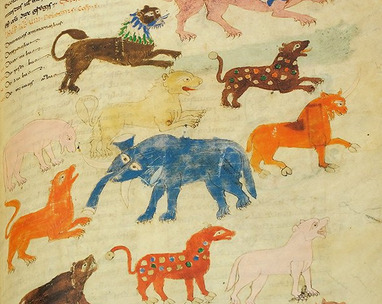#hrabanus maurus
Explore tagged Tumblr posts
Text










pattern poems
in a copy of the "liber de laudibus sanctae crucis" by hrabanus maurus, central or southern france, early 11th century
source: Bern, Burgerbibliothek, Cod. 9
#11th century#carmina figurata#hrabanus maurus#Rabanus Maurus#De laudibus sanctae crucis#pattern poems#medieval art#illuminated manuscript
229 notes
·
View notes
Text

Feeling blue? 1000 years before the blue elephant emoji was added to phones, some Italian monks drew this elephant and friends in a manuscript for Abbot Theobald of Monte Cassino. Monte Cassino was an important monastery and home to St Benedict whose rule is the basis for the Benedictine Order of monks and nuns that still exists today.
This manuscript contains an abbreviation of Hrabanus Maurus's De Rerum Naturis (On the Natures of Things). Hrabanus Maurus (d. 856) was archbishop of Mainz. In addition to encyclodpedia-like works sucha as De Rerum Naturis, he wrote Biblical commentaries, grammars, teaching texts and poems with complex palindromes. He wrote so much that his surviving writings fill about 6 modern type-set volumes.
Materials: parchment, pigments, ink Contents: Hrabanus Maurus, De Rerum Naturis Date: 1022-1032 Now Archivio dell'Abbazia, Montecassino, MS 132 (image from a facsimile)
86 notes
·
View notes
Text
Let's just appreciate the way Lynda L. Coon in her "Dark Age Bodies: Gender and Monastic Practice in the Early Medieval West (2011)" wrote about Alcuin of York's passion for giving bird nicknames to his fellow friends and disciples at the Carolingian court.

Lynda L. Coon, Dark Age Bodies: Gender and Monastic Practice in the Early Medieval West, Philadelphia - Oxford 2011, p. 16
Like I'd never thought I'd read about Alcuin being the master of boy-birds, but here we are.
#also i can't help myself finding the monastic cock nickname amusing#sorry not sorry#alcuin of york#hrabanus maurus#charlemagne#carolingian empire#medieval literature#medieval monks#latin#medieval latin#queer history#monkposting
15 notes
·
View notes
Text
De Laudib[us] sancte Crucis opus. 1503
De Laudib[us] sancte Crucis opus. 1503
469J Rabanus Maurus. 784-856? Magnencij Rabani Mauri De Laudib[us] sancte Crucis opus. erudcione versu prosaq[ue] mirificum. edited by Jacobus Wimpheling. Phorçheim. [Pforzheim : In ædibus Thom[ae] Anshelmi., 1503. $24,000 Folio 31 x 21cm. signatures: Aa6 Bb4 a-k6; A, B6 C4. [Complete] Types 3:109R, 4:180G; 40 lines of transcribed verse + headline, 40 lines of commentary + headline, red…

View On WordPress
#1503#Acrostics#figurative#Hrabanus Maurus#Jacobus Wimpheling#Johann Reuchlin#Rabanus Maurus#Sebastian Brant#shape poems
0 notes
Photo

Bern, Burgerbibliothek, Cod. 9, f. 18v – Hrabanus Maurus, Liber de Laudibus Sanctae Crucis.
Entire manuscript is viewable here: http://www.e-codices.unifr.ch/en/bbb/0009/18v/0/Sequence-22
#rabanus maurus#hrabanus maurus#de laudibus sanctae crucis#angels and saints#palindrome#pattern poem#pattern poetry#sanctus#medieval manuscript#manuscript#illuminated manuscript#middle ages#liber#codex#german#germanic#medieval germany#latin#art history#ancient greek#parchment#folio#marginalia#monastery#monastic art#monk#medieval monk#medieval monastary#religious art#devotional art
11 notes
·
View notes
Photo

Hrabanus Maurus The Invention of Languages 10th century
Source
38 notes
·
View notes
Photo





the blue screen, cross-words and punctuation marks
-> notes (part.1) on ymagine denudari: éthique de l'image et métaphysique de l'abstraction chez maître eckhart (wackernagel)
forms of “extrinsic attributions”
as l. oeing-hanhoff asserts, the history of abstraction has not yet been written, as far as the middle ages are concerned.
semantic levels, from sacred to profane:
● verb-image
● human 'in the image' of the creator
● images 'dissimilar' from the exterior world
ektype/archetype = image-copy/model = 'imago'/'exemplar' = abbild/urbild
“to be generated 'in the image' of god, one must be de-generated from terrestrial filiation and 'un-imaged' from the images of all creatures” (p.34)
rejection from terrestrial filiation < renunciation of oneself < transformation 'in the same image' < divine filiation
'abstractive' function of the intellect, which 'detaches' (abstrahit) from the here and now, from the place and time / entbildung = detachment

1. inquantum (qua) = as = the exclusion of all that is foreign to the (redoubled) term
“the being of all things, as such, is measured by eternity, not by time. Because the intellect whose object is being, and that grasps being before any other thing, abstracts from the here and now, and thus from time” (p.38)
2. the idea of proximity (read: with the absolute), near-consubstantiality
● absolute being, “being is what desires all things” (avicenne)
● being formally inherent to things, “being is actuality” (saint thomas)
3. generator/generated (read: cgi)
● 'real' distinction in divine things, 'where the relation and the things are identical'
● distinction 'by relation and reason' in the things created
29 notes
·
View notes